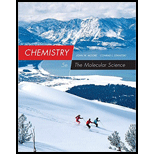
Concept explainers
Assume that a car burns pure octane.
C8H18 (d = 0.703 g/cm3)
(a) Write the balanced equation for burning octane in air. forming CO2 and H2O.
(b) If the car has a fuel efficiency of 32 miles per gallon of octane, what volume of CO2 at 25 °C and 1.0 atm is generated when the car goes on a 10.0-mile trip? (The volume of 1 mol CO2(g) at 25 °C and 1 atm is 24.5 L.)
(a)
Interpretation:
A balanced chemical equation for burning of octane has to be stated.
Concept Introduction:
The performance of an engine or fuel is measured in terms of octane number or octane rating. The processes that are used to increase the octane number of a fuel are known as catalytic cracking and catalytic reforming. Catalytic reforming converts the straight chain hydrocarbon into the branched hydrocarbon.
Answer to Problem 97QRT
A balanced chemical equation for burning of octane is shown below.
Explanation of Solution
The chemical reaction for combustion of octane is as follows.
In the above equation, the number of atoms on reactant and product side is not balanced. In order to balance them, a coefficient of
Therefore, the balanced chemical reaction for combustion of octane is shown below.
(b)
Interpretation:
The volume of
Concept Introduction:
Refer to part (a).
Answer to Problem 97QRT
The volume of
Explanation of Solution
The amount of fuel that is octane required to travel
The relation between gallon and liters is as follows.
Conversion of
The density of octane is
The relation between volume and mass is shown below.
Substitute the density and volume of octane in the above equation.
The molar mass of octane is
Substitute the mass and molar mass of octane in the above equation.
From the balanced chemical equation for combustion of octane, it is known that one mole of octane gives
Therefore, the number of moles of
The volume of
Want to see more full solutions like this?
Chapter 10 Solutions
Bundle: Chemistry: The Molecular Science, 5th, Loose-Leaf + OWLv2 with Quick Prep 24-Months Printed Access Card
- How does hydraulic fracturing differ from previously used techniques for the recovery of natural gas from the earth?arrow_forwardDetermine the volume of CO2 obtained from the combustion of 145 g propane, C3H8 (at 1741 mmHg and 250°C). C3H8 + O2 -> CO2 + H2Oarrow_forward1. Give equations for the preparation of methane by two other methods.2. Calculate the volume of air required for the combustion of 2 liters of ethane.arrow_forward
- How many grams of oxygen are required to react completely with 6.00 moles of benzene?arrow_forwardAssume that a single cylinder of an automobile engine hasa volume of 524 cm3. (a) If the cylinder is full of air at 74 °C and 0.980 atm, how many moles of O2 are present? (Themole fraction of O2 in dry air is 0.2095.) (b) How manygrams of C8H18 could be combusted by this quantity ofO2, assuming complete combustion with formation ofCO2 and H2O?arrow_forwardHow many liters of CO2 would be produced at STP from the combustion of 29.1 gg of ethylcyclopentane?arrow_forward
- The citizens of the world burn the fossil fuel equivalent of 7 * 1012 kg of petroleum per year. Assume that all of this petroleum is in the form of octane (C8H18) and calculate how much CO2 (in kg) the world produces from fossil fuel combustion per year. (Hint: Begin by writing a balanced equation for the combustion of octane.) If the atmosphere currently contains approximately3 * 1015 kg of CO2, how long will it take for the world’s fossil fuel combustion to double the amount of atmospheric carbon dioxide?arrow_forwardHow many grams of sodium hydrogen carbonate decompose to give 28.7 mLmL of carbon dioxide gas at STP? 2NaHCO3(s)⟶ΔNa2CO3(s)+H2O(l)+CO2(g)arrow_forwardGlycine is an amino acid made up of carbon, hydrogen, oxygen, and nitrogen atoms. Two samples of glycerine are combusted during an experiment to determine the empirical formula of glycerine. Sample 1: Combustion of a 0.2036 g sample produced 132.9 mL of CO2 at 25°C and 1.00 atm. and 0.122 g of water. Sample 2: 0.2500 g of glycine is treated in such a way that all the nitrogen atoms are converted to N2 gas. The volume of the nitrogen gas collected was 40.8 mL at 25°C and 1.00 atm. Determine: 1. The percentages of carbon and hydrogen in glycine. 2. The percentage of nitrogen in glycine. 3. The percentage of oxygen in glycine. 4. The empirical formula of glycine.arrow_forward
- what is the density in g/L (STP) of SO2?arrow_forwardWhat volume of oxygen will be required for the complete combustion of 54 L of hydrogen if both gases are measured at the same temperature and pressure. 4 H2 (g) + 2 O2 (g) → 4 H2O (l)arrow_forwardEthane (C2H6) is burned with atmospheric air, and the volumetric analysis of the dry products of combustion yields the following: 10% CO2, 1% CO, 3% O2, and 86% N2. (a) What is the complete combustion equation? (b) What is the theoretical oxygen? (c) What is the percentage of excess air? (d) What is the volume of air in liters (at 25 OC and 1 atm) per / kg fuel?arrow_forward
 Chemistry: The Molecular ScienceChemistryISBN:9781285199047Author:John W. Moore, Conrad L. StanitskiPublisher:Cengage Learning
Chemistry: The Molecular ScienceChemistryISBN:9781285199047Author:John W. Moore, Conrad L. StanitskiPublisher:Cengage Learning Chemistry for Engineering StudentsChemistryISBN:9781337398909Author:Lawrence S. Brown, Tom HolmePublisher:Cengage Learning
Chemistry for Engineering StudentsChemistryISBN:9781337398909Author:Lawrence S. Brown, Tom HolmePublisher:Cengage Learning

